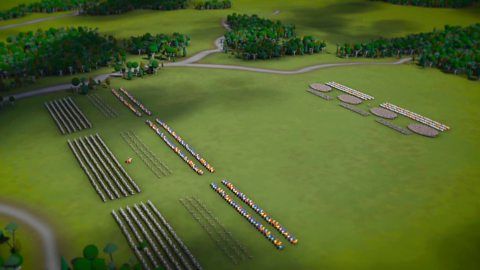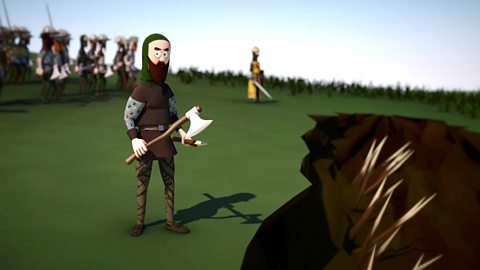King Edward I of England's army was defeated by William Wallace and Andrew Murray at Stirling Bridge in 1297, Edward was determined to beat the Scots at the Battle of Falkirk on 22 July, 1298.
Find out about the Battle of Falkirk
NARRATOR:The Wars of Independence. The Battle of Falkirk 1298.
Two years ago King Edward I of England invaded Scotland. Last year, Scotland started to fight back when William Wallace’s army beat the English army at Stirling Bridge.
But now King Edward is personally leading an army to crush all resistance to English rule. Wallace has been running from Edward’s Army, hoping to tire the English out, like a giant game of tig!
But, finally, King Edward has caught up with Wallace outside Falkirk.
You are an archer, You are right in front. Hoping to shoot the enemy – when they’re close enough – but not too close!
ARCHER:Oh, that’s a big army. There must be three times as many English as us!
I wish I was in that Schiltron, that big hedgehog made up of men with pikes. I bet they feel much safer.
Me, I’ve got this bow. I know how far my arrows can fly and there’s not one Englishman near enough to hit.
NARRATOR:The Scottish Knights charge but seeing the numbers of the English, they realise they can’t win, so they gallop away.
ARCHER:Whit! Where are you going! Come back!
NARRATOR:Next Edward takes command of his knights. He commands them to attack the Scottish archers.
ARCHER:I… I only get one shot off. By the time I get another arrow out, I’m looking at ARGH! I’m getting out of here!
NARRATOR:With the Scottish Archers killed or scattered by the English knights, Edward orders his archers to destroy the schiltrons. They’re armed with Welsh longbows!
No other weapon can do as much damage, at such distances, again and again. It’s far more powerful than the bows the Scots have!
The English Army fire at one Scottish Schiltron at a time. Breaking up the walls of spears. And as soon as there’s enough space, the English Knights charge in.
Edward might have had a bigger army and better weapons, but it was his plan, his strategy that won the day. If Wallace had a plan, it didn’t work. The Scots who could, fled the battlefield.
Wallace resigns from being Guardian of Scotland and returns to what he did best: fighting from the forests and not on the battlefield.
It would be another eight years until somebody else would challenge the English on the battlefield – Robert the Bruce.
Why did William Wallace lose the battle?
Wallace had beaten a larger English army at the Battle of Stirling Bridge. So why did he lose this time?
At Stirling, Wallace had placed his soldiers in large, tightly-packed groups called schiltrons.
The men had been armed with long pikes and the groups looked like hedgehogs and the English knights couldn't fight their way past them
At Falkirk Edward I had learned his lesson.
Rather than fighting the schiltrons close up with knights on horses, he used archers armed with longbows to attack them from a safe distance.
The Scottish archers used much smaller bows that could only be used close up. This gave the English archers a big advantage.
Battle of Falkirk: Key moments

Image caption, Outnumbered
The two armies met at Falkirk on 22 July 1298. The Scottish army was led by William Wallace and had 6,000 men. The English army had 15,000 men and was led by King Edward I.
1 of 6

Longbow facts
- Longbows could be six-feet long
- They could be taller than the men that used them
- They had great range - more than twice the length of a football pitch!
- The arrows they fired could pierce armour
The Scottish soldiers didn't stand a chance!

Battle map
Click on the interactive to see how the two sides lined up on the battlefield:
More on Wars of Independence
Find out more by working through a topic
- count11 of 13

- count12 of 13

- count13 of 13

- count1 of 13
